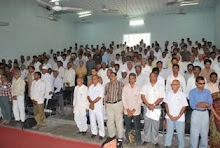Times of India: Nagpur: Sunday,
February 03, 2013.
Excessive
emissions from Koradi and Khaparkheda power plants of Mahagenco have often
caused lot of problems for people living in the area adjoining the two plants.
TOI has highlighted this issue several times. Whenever, TOI asked the
authorities about the reason they said that the plant was receiving high ash
coal and the next lot would be cleaner.
Now this
claim has proved to be a lie. City lawyer Manoj Garg has obtained information
under RTI which shows that Mahagenco plants rarely use coal whose fly-ash content
is below the maximum permissible limit of 34%. He is planning to file a public
interest litigation (PIL) against excessive emissions from Mahagenco plants.
Garg has
obtained data pertaining to Nasik and Paras (near Balapur town of Akola
district) plants. He is awaiting data of Koradi and Khaparkheda plants. The
data of Nasik plant is for the period September-November 2012 and covers the
three 210MW units. The data of Paras plant is for the same period and covers
the two 250MW units. He has claimed that coal supplied to Koradi and
Khaparkheda plants had over 50% ash content on an average.
Mahagenco has
provided the fly-ash content in coal supplied to Nasik plant at two stages. The
first is when it arrives in the plant (air dry basis) and the second is when it
is fed to the boiler (as fired basis). The ash content reduces for fired basis
as the moisture content increases due to spraying of water to prevent the coal
from catching fire.
The maximum
permissible fly-ash content in coal fed to power plants is 34% according to the
norms of ministry of environment and forests (MoEF) and Maharashtra Pollution
Control Board (MPCB). However, on many days coal in Nasik had over 50% ash. The
coal quality in Paras is slightly better.
Sudhir
Paliwal of Vidarbha Environmental Action Group (VEAG) said that even China,
which is infamous for pollution, did not use such high ash content coal.
"If coal has such high ash content the emissions are bound to be far
higher than permissible limit. Moreover, the pollution control equipment of
Mahagenco don't work properly and this exacerbates the problem. The company
also illegally discharges sludge having high ash content into streams," he
rued.
Garg told TOI
that Physicians for Social Responsibility (PSR), a NGO that had received Nobel
Prize for its contribution to environment protection, has stressed that fly-ash
was one of the biggest health hazards in United States. "The organization
had written a letter to US President Barack Obama saying there were no
stringent norms for regulating disposal of fly-ash. In US there are some norms
and people are more vocal about their rights. The condition is worse
here," he said.














































































